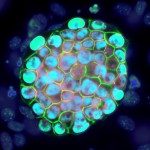Link to Pubmed [PMID] – 11226047
Reproduction 2001 Feb;121(2):229-37
The KIT receptor, present on oocyte and theca cells in ovarian follicles, and its ligand, KIT LIGAND, produced by granulosa cells, are encoded at the Kit gene and the Mgf gene, respectively. Both Kit and Mgf mutations affect oogenesis and folliculogenesis. In this study, the ovarian function of heterozygous mice with a mutation Kit(W-lacZ) was examined. Firstly, the amounts of KIT and KIT LIGAND proteins in the ovaries of mice at different ages were determined. Secondly, in vivo and in vitro folliculogenesis of wild type and heterozygous mice were compared. Western blotting showed that the amounts of both KIT and KIT LIGAND proteins were decreased in mutant mice. Ovarian follicle populations were counted and more type 5a follicles and fewer type 5b (preantral follicles) were present in ovaries from Kit(W-lacZ/+) ovaries. Furthermore, the relationships between oocyte size and follicle size differed between wild type and heterozygous mice. This finding may be a consequence of altered proliferation of granulosa cells or of altered oocyte growth in mutant mice. Other features of folliculogenesis, such as initiation of follicular growth, total follicle population and follicular atresia, were not affected by the mutation. Analysis of in vitro folliculogenesis did not reveal other differences between wild type and mutant mice. It is concluded that the Kit(W-lacZ) mutation affects the expression of KIT and KIT LIGAND proteins, resulting in alterations in granulosa cell proliferation and/or oocyte growth in preantral follicles.

